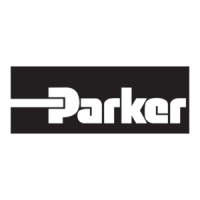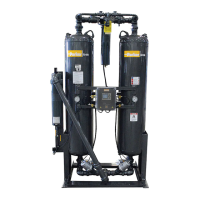Important! The dryer is designed to remove only water vapor. You might see a small amount of
condensate forming at the exhaust due to the Joule-Thomson cooling effect created by the depressurizing
air.
Prior to switching a freshly regenerated bed “on-line” to become the drying bed, it must be slowly
pressurized from atmospheric pressure to line pressure. This step is called repressurization.
Repressurization prevents bed fluidization (lifting) and associated dusting.
Following repressurization, the beds switch functions with the fresh bed now drying and the
saturated bed being regenerated.
Note that one bed is always “on-line” drying. Also note that purge air is always being consumed
except during repressurization.
This cycle will continue automatically unless the dryer is shut down, operated in the Cycle Loc mode or
equipped with a Powerloc or Pro Purge.
SECTION 4 Sequence of Operation
The sequence is controlled by a Solid State Timing and Relay circuit (Sequence Annunciator) which in
turn controls five electric solenoid valves. The first four are 3-Way Normally Closed Valves, which
supply control air to operate air operated diaphragm inlet and exhaust valves. The Inlet Valves are
Normally Open and are closed by applying pressure to the top surface of the diaphragm. The Exhaust
Valves are Normally Closed and are opened by applying pressure to the underneath of the diaphragm.
The fifth solenoid is a 2-Way normally closed valve. This is the repressurization valve. There are also
four mechanical check valves, two outlet and two purge, that allow for proper air flow.
STEP 1
- LEFT DRYING; RIGHT REGENERATING SOLENOID #1 is de-energized sending no air to
Exhaust Valve #1 (left side). Exhaust Valve #1 is closed.
SOLENOID #2 is de-energized sending no air to Inlet Valve
#1 (left side). Inlet Valve #1 is open. All of the wet inlet air is flowing through Inlet Valve #1. It is dried as it
passes through the left tower desiccant bed and exits out the left side Outlet Check Valve to the dryer
outlet. The left tower is the Drying tower and the associated pressure gauge should read line pressure,
typically 100 PSIG.
At the same time SOLENOID #3 is energized sending a signal to Inlet Valve #2 (right side). Inlet Valve #2
is closed, preventing inlet air flow through the right tower.
SOLENOID #4 is energized sending a signal to Exhaust Valve #2 (right side). Exhaust Valve #2 is open.
(NOTE: When exhaust valve first opens, the associated tower will depressurize from line pressure to
atmospheric pressure.) Purge air will now flow from the dry air outlet through the Purge Adjusting valve,
Purge Orifice and the right hand Purge Check Valve. This purge air then proceeds through the right tower
near atmospheric pressure, removing the moisture and exiting the right hand Exhaust Valve and Muffler in
vapor form (at no time should the dryer expel any significant amount of liquid water from the muffler; this is
a sure sign of trouble in the system). The right tower is the regenerating tower, the associated pressure
gauge should read “0” PSIG.
SOLENOID #5 is de-energized and closed.
STEP 2
- LEFT DRYING, RIGHT REPRESSURIZING
While the left tower is still drying, Solenoid #4 will de- energize, relieving the control air signal on the right
exhaust valve, returning that valve to its normally closed state. Closing this valve keeps air in the tower,
allowing the depressurized part of the dryer to build up pressure or
“repressurize”. At the same time Solenoid #5 is energized and opened, providing additional air to the tank
coming from the purge line to ensure full repressurization of the dryer.
Prior to switching towers, all of the gauges should equalize to line pressure.
STEP 3 - LEFT REGENERATING, RIGHT DRYING
